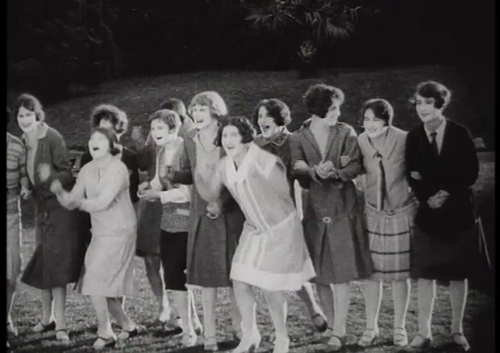
By Ellen Pullar (NZFA Publicist)
This blog post looks back to 1927, at a little fizzer of a short film called Who’s For Hollywood: Series 2, which is part of the Film Archive’s collection. The original is on nitrate film, but the Archive has digital preservation copies – watch the film online here. The four-minute film showcases the Auckland semi-finalists in competition for the title of Miss New Zealand 1927. It depicts the hunt for an exemplary model of New Zealand girlhood, at a time when our nation had not yet come into its own as a country – the film bears the influence of both Britain and Hollywood.
Hero image: Screengrab from the 1927 film, 'Who’s for Hollywood, Series 2' - Auckland semi-finalists in the 'Miss New Zealand' competition, cheering on a rugby game at Carlaw Park. (1927)

Screengrab from the 1927 film, 'Who’s for Hollywood, Series 2' - the girls cheer on their team. (1927)
1927 was the second year the competition had run, but this year’s competition offered an extra incentive that the 1926 competition had not – this time a Hollywood contract was up for grabs. Metro-Goldwyn-Mayer was a major pageant sponsor, with support from Fuller-Hayward Theatres, J.C. Williamson’s Theatres, and newspapers based in Auckland, Wellington, Christchurch and Dunedin.
An advertisement encouraging entries enthused: “Just imagine for a moment what she will feel like with an engagement of £25 weekly before her! Never has such an opportunity been offered. The gates of the Culver City studios, the Mecca of girls from all parts of the world, will be wide open for her” (Auckland Sun, 2 June 1927, p. 11).
According to the Auckland Sun (1 June 1927, p. 11) the grand prize encompassed:
- Two first class fares for self and chaperone from New Zealand to Los Angeles and return: £225
- Studio engagement with Metro-Goldwyn-Mayer Incorporated, for the duration of a feature film, at £25 a week, valued at: £275
- Pocket money: £100
- Wardrobe: £150
- Chaperone’s allowance: £150
- TOTAL: £900
Quite an opportunity for a girl from little wee New Zealand!
Beauty pageants have been intertwined with nationalism since their inception. According to gender historian Lois Banner, the Miss America beauty pageant, which first took place in 1921, “seemed to enshrine the ‘bathing beauty,’ with her proud display of a semi-nude body, as a central symbol of American women” (American Beauty, p. 249). Banner points out that the Miss Americas chosen were not necessarily singularly beautiful, rather they were even-featured women who were seen to be representative of wholesome, young American womanhood.
The Miss New Zealand pageants of the 1920s where shaped by similar preoccupations. Adverts calling for entries extolled the wholesome virtues of New Zealand’s girls:
“Throughout New Zealand there are thousands of girls of the best type, who can hold their own in the world of sport – swimming, riding, tennis and a host of other pastimes. Skill in sport infers training, mental and physical, the ability to ‘play the game’ in true British fashion, moulding thus the character and personality of which adds up to the beauty of girlhood.” – Auckland Sun, 1 June 1927, p. 11
In blurbs such as this, and other promotion for the competition, we see a layering of American, British and uniquely New Zealand values – which were still being defined, and were often conflated with British values. The idea of a beauty pageant was an American phenomenon – then there was the golden prize of the Hollywood contract. Athletic skill and sportsmanship, however, are imagined as British values. In Who’s For Hollywood: Series 2 the contestants are first seen enthusiastically cheering on a rugby game at Carlaw Park – although their haute couture outfits and high heels would seem to be improbable attire for standing at the sideline, in the mud. The girls are given opportunity to demonstrate their range of emotions on screen when their team scores a try, or misses a conversion.
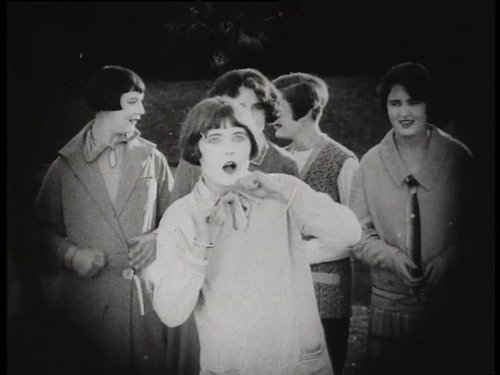
Screengrab from the 1927 film, 'Who’s for Hollywood, Series 2' - reacting dramatically when a conversion is missed. (1927)
In the next scene one contestant, Miri Bragato, smiles winningly while demonstrating her golf swing. Others, Norma Phair and Hazel Simpson, play tennis.
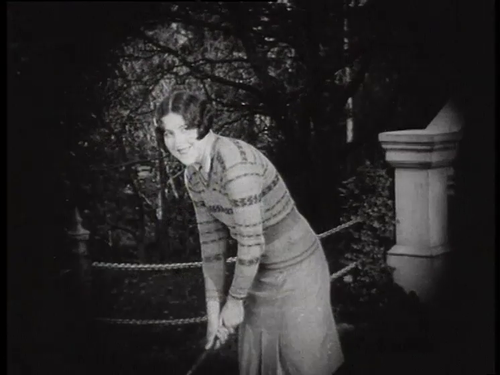
Screengrab from the 1927 film, 'Who’s for Hollywood, Series 2' - Miri Bragato demonstrates her golf swing. (1927)

Screengrab from the 1927 film, 'Who’s for Hollywood, Series 2' - Hazel Simpson plays tennis. (1927)
Later Distin Strange reads a book under a tree, against a waterside landscape. Her beauty is set against New Zealand’s natural beauty. This connection is made even more explicit in a promotional photograph for the 1926 pageant, in which the contestants pose underneath a pohutukawa tree (published in the Auckland Star, 3 November, 1926, p. 10).
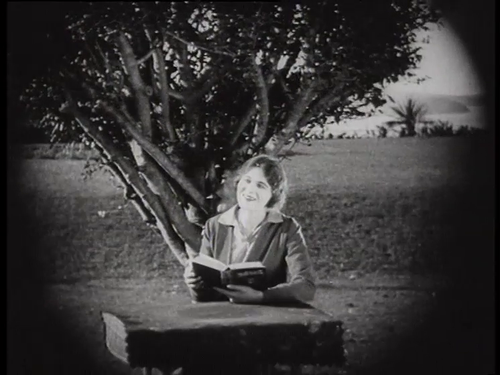
Screengrab from the 1927 film, 'Who’s for Hollywood, Series 2' - Distin Strange reads against a scenic NZ landscape. (1927)
The film was made at a moment when the concept of “personality” was under revision. According to film historian Samantha Barbas, a growing mass and consumer culture from the first decade of the twentieth century had led to an increased interest in, and redefinition of, the concept of “personality” in the US. By the 1920s the term “personality” had acquired a new meaning, “as a description by itself for a particular set of characteristics: charm, attractiveness, magnetism” (Barbas, Movie Crazy, p. 42). In contrast to nineteenth century notions of personality – which had revolved around the ideas of character, morality and sincerity – the new concept of personality as synthetic advocated self-representation through the extensive cultivation of an individual’s image and appearance. A shift from depth to surface. The change coincided, not coincidentally, with the rise of the Hollywood star system, which churned out dazzling “personalities” – and beauty pageants worked towards a similar agenda.
The newspaper passage mentioned above, which talks about the ability to play sports in “true British fashion” as “moulding […] the character and personality,” reflects the old-fashioned notion of personality.
Yet the new notion of “personality” was represented in modern girl type that recurs in the Miss New Zealand newspaper and film publicity – the contestants are all dressed in up-to-the-minute fashions, they wear makeup (newly popularised and somewhat scandalous in the 1920s) and style their hair in trendy bobs. The modernness of the Miss New Zealand contestants was perceived as shocking by some (have beauty pageants always been synonymous with scandal?), a fact that the NZ Truth played to in an article exposing the tawdry side of the pageant. In the lengthy article (2 December 1926, p. 7), the Truth makes a barrage of accusations against the pageant organisers. These include, among others: that one-sided contracts prohibited contestants from accepting any other form of employment, processes for selection and advancement in the competition were not transparent, and – this the article dwells upon – the girls objected to the “nightly ordeal” of being forced to parade in front of audiences in bathing suits:
“they faced a veritable battery of binoculars, field glasses and opera glasses levelled by individuals of the male sex, who gazed from all parts of the house with greedy eyes upon the girlish faces and forms paraded before them like so many prize cattle.”
And even worse: “not only must they parade in bathing costumes but that those costumes must be of knitted silk and one piece garments” (presumably more revealing than other types of swimwear).
While the competition reverberated with scandal and sexuality, the organisers were keen to present the female sexuality represented as a wholesome one – in keeping with the girls’ role as representatives of New Zealand identity. The competition rules set a score on innocence, stating that contestants must never have been married, and, furthermore, finalists would be accompanied by personal chaperones during all stages of the competition (Auckland Sun, 1 June 1927, p. 11). In the film, Miss Kathleen Sanderson cuddles a cat and looks posi-lute-ly girlish. Then Freda Crosher, all giggles, plays with a small dog. With their healthy, youthful and sporty bodies, and innocent playfulness, these young women embody the “Daughter of New Zealand” stereotype evoked in so much of the pageant’s promotion.

Screengrab from the 1927 film, 'Who’s for Hollywood, Series 2' - Freda Crosher plays with a cat. (1927)
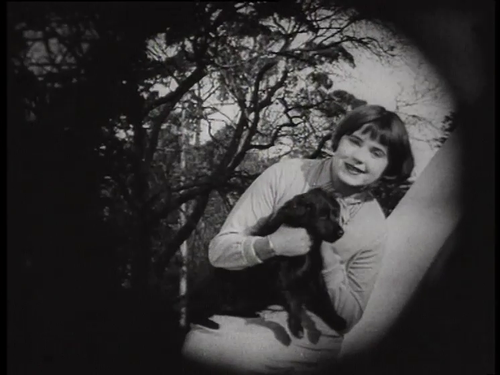
Screengrab from the 1927 film, 'Who’s for Hollywood, Series 2' - Freda Crosher plays with a dog. (1927)
The 1927 pageant was a real multimedia event. The newspapers printed photos of the narrowing list of finalists throughout the duration of the competition, the finalists toured centres nationwide making live appearances at the local theatres, and Who’s For Hollywood: Series 2 was just one of a series of films on the pageant that showed in theatres as a prelude to the Hollywood feature. In the end though, the Miss New Zealand title and the Hollywood contract were not won by any of the Auckland contestants showcased in this film, but by Dale Austen, of Dunedin.
Sources:
- Advert. Auckland Sun, 1 June 1927, p. 11.
- Advert. Auckland Sun. 2 June 1927, p. 11.
- Banner, Lois W. American Beauty. Chicago/London: University of Chicago Press, 1984.
- Barbas, Samantha. Movie Crazy: Fans, Stars and the Cult of Celebrity. New York: Palgrave, 2001.
- “How N.Z. Entertainers, Ltd., Treated and Exploited the Finalists.” NZ Truth. 2 December 1926, p. 7.
- “Under the Pohutukawa Tree.” Auckland Star. 3 November, 1926, p. 10.